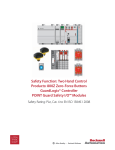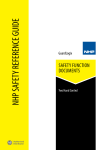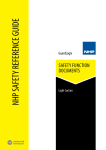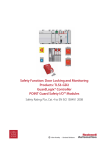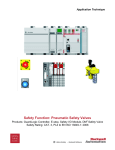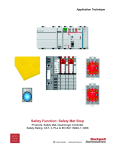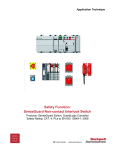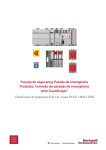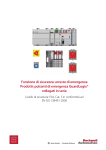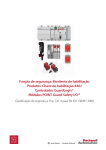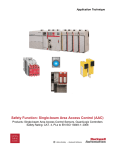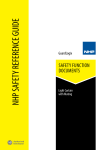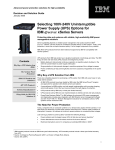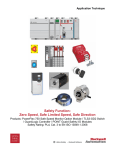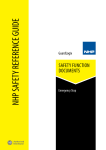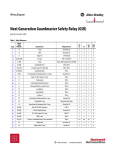Download Safety Function: Cable Pull Switch
Transcript
Application Technique Safety Function: Cable Pull Switch Products: GuardLogix Series Connection of Cable Pull Switches Safety Rating: PLd, Cat. 3 to EN ISO 13849-1: 2008 2 Safety Function: Cable Pull Switch Important User Information Solid-state equipment has operational characteristics differing from those of electromechanical equipment. Safety Guidelines for the Application, Installation and Maintenance of Solid-state Controls (publication SGI-1.1 available from your local Rockwell Automation sales office or online at http://www.rockwellautomation.com/literature) describes some important differences between solid-state equipment and hard-wired electromechanical devices. Because of this difference, and also because of the wide variety of uses for solid-state equipment, all persons responsible for applying this equipment must satisfy themselves that each intended application of this equipment is acceptable. In no event will Rockwell Automation, Inc. be responsible or liable for indirect or consequential damages resulting from the use or application of this equipment. The examples and diagrams in this manual are included solely for illustrative purposes. Because of the many variables and requirements associated with any particular installation, Rockwell Automation, Inc. cannot assume responsibility or liability for actual use based on the examples and diagrams. No patent liability is assumed by Rockwell Automation, Inc. with respect to use of information, circuits, equipment, or software described in this manual. Reproduction of the contents of this manual, in whole or in part, without written permission of Rockwell Automation, Inc., is prohibited. Throughout this manual, when necessary, we use notes to make you aware of safety considerations. WARNING: Identifies information about practices or circumstances that can cause an explosion in a hazardous environment, which may lead to personal injury or death, property damage, or economic loss. ATTENTION: Identifies information about practices or circumstances that can lead to personal injury or death, property damage, or economic loss. Attentions help you identify a hazard, avoid a hazard, and recognize the consequence. SHOCK HAZARD: Labels may be on or inside the equipment, for example, a drive or motor, to alert people that dangerous voltage may be present. BURN HAZARD: Labels may be on or inside the equipment, for example, a drive or motor, to alert people that surfaces may reach dangerous temperatures. IMPORTANT Identifies information that is critical for successful application and understanding of the product. Rockwell Automation Publication SAFETY-AT092A-EN-P – August 2013 Safety Function: Cable Pull Switch 3 General Safety Information Contact Rockwell Automation to find out more about our safety risk assessment services. IMPORTANT This application example is for advanced users and assumes that you are trained and experienced in safety system requirements. ATTENTION: Perform a risk assessment to make sure all task and hazard combinations have been identified and addressed. The risk assessment can require additional circuitry to reduce the risk to a tolerable level. Safety circuits must take into consideration safety distance calculations, which are not part of the scope of this document. Table of Contents Introduction ............................................................................................................... 4 Safety Function Realization: Risk Assessment ......................................................... 4 Cable Pull Switch Safety Function ............................................................................ 5 Safety Function Requirements .................................................................................. 5 Functional Safety Description ................................................................................... 5 Bill of Material ........................................................................................................... 6 Setup and Wiring ...................................................................................................... 7 Configuration ............................................................................................................ 8 Programming .......................................................................................................... 16 Calculation of the Performance Level...................................................................... 18 Verification and Validation Plan............................................................................... 20 Additional Resources .............................................................................................. 25 Rockwell Automation Publication SAFETY-AT092A-EN-P – August 2013 4 Safety Function: Cable Pull Switch Introduction This safety function application technique explains how to wire, configure, and program a Compact GuardLogix® controller and POINT Guard I/O™ module to monitor a series of dual-channel cable pull switches. If any of the cable pull switches are actuated or a fault is detected in the monitoring circuit, the GuardLogix controller de-energizes the final control device, in this case, a redundant pair of 100S contactors. This example uses a Compact GuardLogix controller, but is applicable to any GuardLogix controller. Safety Function Realization: Risk Assessment The required performance level is the result of a risk assessment and refers to the amount of the risk reduction to be carried out by the safety-related parts of the control system. Part of the risk reduction process is to determine the safety functions of the machine. For the purposes of this document, the assumed required performance level is Performance Level d, Category 3 (PLd, Cat. 3). From: Risk Assessment (ISO 12100) 1. Identification of safety functions 2. Specification of characteristics of each function 3. Determination of required PL (PLr) for each safety function To: Realization and PL Evaluation Rockwell Automation Publication SAFETY-AT092A-EN-P – August 2013 Safety Function: Cable Pull Switch 5 Cable Pull Switch Safety Function This application includes one safety function: the emergency stop by actuation of a cable pull switch. Safety Function Requirements Pulling of any one of the series-wired cable pull switches stops and prevents hazardous motion by removing power to the motor. When the cable pull switch is reset, hazardous motion and power to the motor do not resume until a secondary action occurs — the Reset button is pressed. A fault at the cable pull switch, wiring terminals, or safety controller is detected before the next safety demand. The cable pull switch is an added machine safeguard; it does not replace other safety functions. The safety function in this example is capable of connecting and interrupting power to motors rated up to 9 A, 600V AC. The safety function meets the requirements for Performance Level d, Category 3, per EN ISO 13849-1 and control reliable operation per ANSI B11.19. Functional Safety Description Hazardous motion is interrupted or prevented by actuation of cable pull switch (pull cord 1 or pull cord 2). Each cable pull switch is considered a separate safety function. The cable pull switches are connected in series to a pair of safety inputs of a safety input module (catalog number 1734-IB8S). The safety contactors (K1 and K2) are connected to a pair of safety outputs of a safety output module catalog number (1734-OB8S). The I/O modules are connected via CIP Safety over an EtherNet/IP network to the safety controller. The safety code in the GuardLogix controller monitors the status of the cable pull switches by using a pre-certified safety instruction named Dual Channel Input Stop (DCS). When pre-conditions are satisfied, no faults are detected on the input modules, and the Reset button is pressed, a second certified function block called Configurable Redundant Output (CROUT) checks the status of the final control devices, a pair of 100S redundant contactors. The controller then issues an output signal to the safety output module (catalog number 1734-OB8S) to switch on a pair of outputs to energize the safety contactors. Rockwell Automation Publication SAFETY-AT092A-EN-P – August 2013 6 Safety Function: Cable Pull Switch Bill of Material This application uses these products. Cat. No. Description Quantity 440E-L13137 440E emergency stop device – Lifeline™ 4-cable pull switch 2 800FM-G611MX10 800F push button - metal, guarded, blue, R, metal latch mount, 1 N.O. contact, standard 1 100S-C09ZJ23C Bulletin 100S-C - safety contactors 2 1768-ENBT CompactLogix™ EtherNet/IP bridge module 1 1768-L43S Compact GuardLogix processor, 2.0 Mb standard memory, 0.5 Mb safety memory 1 1768-PA3 Power supply, 120/240V AC Input, 3.5 A @ 24V DC 1 1769-ECR Right end cap/terminator 1 1734-AENT 24V DC Ethernet adapter 1 1734-TB Module base with removable IEC screw terminals 4 1734-IB8S POINT Guard I/O safety input module 1 1734-OB8S POINT Guard I/O safety output module 1 1783-US05T Stratix 2000™ unmanaged Ethernet switch 1 Rockwell Automation Publication SAFETY-AT092A-EN-P – August 2013 Safety Function: Cable Pull Switch 7 Setup and Wiring For detailed information on installing and wiring, refer to the publications listed in the Additional Resources on the back cover. System Overview The 1734-IB8S input module monitors the inputs from a series of cable pull switches. This method conserves the number of inputs that are used, but reduces the granularity of system diagnostics. Typically, cable pull switches are not operated as often as a safety gate. For example, the need to connect each switch contact into its own dedicated input is reduced. EN 12100-2 5.5.1 describes additional protective measures. The circuit is tested by using test pulses (T0 and T1) on the inputs, I0 and I1. These test pulses source the 24V DC for the circuit. By periodically dropping the 24V DC to 0V DC, it is possible to detect cross-channel faults and shorts to an external 24V DC. Shorts to 0V DC are seen as an open circuit by the input and are detected by either the hardware, if configured to detect discrepancy errors, or by the appropriate safety function block in the application code. The final control device in this case is a pair of 100S safety contactors (K1 and K2). The contactors are controlled by a 1734-OBS safety output module. These are wired in a redundant configuration and are tested on start-up for faults. The start-up test is accomplished by using a Configurable Redundant Output (CROUT) instruction to monitor the feedback circuit into input 7 (I7) before the contactors are energized. The system is reset by means of the momentary push button, PB1. Rockwell Automation Publication SAFETY-AT092A-EN-P – August 2013 8 Safety Function: Cable Pull Switch Electrical Schematic 1734-IB8S PULL CORD 1 PULL CORD 2 1734-OB8S PB2 FAULT_RESET PB1 RESET Rockwell Automation Publication SAFETY-AT092A-EN-P – August 2013 Safety Function: Cable Pull Switch Configuration The Compact GuardLogix controller is configured by using RSLogix™ 5000 software, version 17 or later. You must create a new project and add the I/O modules, then configure the I/O modules for the correct input and output types. A detailed description of each step is beyond the scope of this document. Knowledge of the RSLogix programming environment is assumed. Configure the Controller and Add I/O Modules 1. In RSLogix 5000 software, create a new project. 2. Choose a controller. a. From the Type pull-down menu, choose 1768-L43S CompactLogix 5343S Safety Controller. b. From the Revision pull-down menu, choose the appropriate revision for the controller. c. In the Name box, type an appropriate name for the controller. d. Click OK. Rockwell Automation Publication SAFETY-AT092A-EN-P – August 2013 9 10 Safety Function: Cable Pull Switch 3. In the Controller Organizer, right-click 1768-ENBT and choose New Module. 4. Select the 1768-ENBT module and click Create. 5. Name the module, type its IP address, and click OK. For this application example, we used 192.168.1.8; however, your IP address can be different. Rockwell Automation Publication SAFETY-AT092A-EN-P – August 2013 Safety Function: Cable Pull Switch 11 6. In the Controller Organizer, right-click the 1734-ENBT module and choose New Module. 7. Select the 1734-AENT adapter. 8. Click Create. 9. Name the module, type its IP address, and click Change. For this application example, we used 192.168.1.11; however, your IP address can be different. Rockwell Automation Publication SAFETY-AT092A-EN-P – August 2013 12 Safety Function: Cable Pull Switch The Module Definition dialog box appears. 10. From the Chassis Size pull-down menu, choose 3. Chassis size is the number of modules that are inserted in the chassis. The 1734-AENT adapter is considered to be in slot 0; therefore, for one input and one output module, the chassis size is 3. 11. Click OK. 12. In the Controller Organizer, right-click the 1734-AENT adapter and choose New Module. Rockwell Automation Publication SAFETY-AT092A-EN-P – August 2013 Safety Function: Cable Pull Switch 13 13. Expand Safety, select the 1734-IB8S module, and click Create. 14. In the New Module dialog box, name the device CellGuard_1 and click Change. The Module Definition dialog box appears. Rockwell Automation Publication SAFETY-AT092A-EN-P – August 2013 14 Safety Function: Cable Pull Switch 15. From the Input Status pull-down menu, choose Combined Status-Power-Muting, and click OK. 16. Repeat steps 12…15 to add the 1734-OB8S safety output module. Rockwell Automation Publication SAFETY-AT092A-EN-P – August 2013 Safety Function: Cable Pull Switch Configure the I/O Modules Follow these steps to configure the POINT Guard I/O modules. 1. In the Controller Organizer, right-click the 1734-IB8S module and choose Properties. 2. Click Input Configuration and configure the module as shown. 3. Click Test Output and configure the module as shown. 4. Click OK. 5. In the Controller Organizer, right-click the 1734-OB8S module and choose Properties. 6. Click Output Configuration and configure the module as shown. 7. Click OK. Rockwell Automation Publication SAFETY-AT092A-EN-P – August 2013 15 16 Safety Function: Cable Pull Switch Programming The Dual Channel Input Stop (DCS) instruction monitors dual-input safety devices whose main function is to stop a machine safely. For example, an E-stop, light curtain, or safety gate. This instruction can energize output 1 only when both safety inputs, channel A and channel B, are in the active state as determined by the Input Type parameter, and the correct reset actions are carried out. The DCS instruction monitors dual-input channels for consistency (Equivalent – Active High) and detects and traps faults when the inconsistency is detected for longer than the configured Discrepancy Time (ms). The Configurable Redundant Output (CROUT) instruction controls and monitors redundant outputs. The reaction time for output feedback is configurable. The instruction supports positive and negative feedback signals. If the input channel resets automatically, the safety application code in the safety output routine prevents outputs from restarting, providing anti-tiedown functionality for the Circuit Reset. The Input OK status is used as a permissive in the safety output routines. Rockwell Automation Publication SAFETY-AT092A-EN-P – August 2013 Safety Function: Cable Pull Switch Rockwell Automation Publication SAFETY-AT092A-EN-P – August 2013 17 18 Safety Function: Cable Pull Switch Falling Edge Reset EN ISO 13849-1 stipulates that instruction reset functions must occur on falling edge signals. In the code shown above, a One Shot Falling (OSF) instruction has been added immediately preceding the Zone1_OutputEnable rung, The OSF instructions Output Bit tag is used as a reset bit for the following rung. The Zone1_OutputEnable is then used to enable the CROUT instruction. Calculation of the Performance Level When configured correctly, the safety system can achieve a safety rating of Performance Level d, Category 3 (PLd, Cat. 3), according to EN ISO 13849-1: 2008. When modeled in SISTEMA Software PL Calculation Tool, each safety-cable pull switch is treated as an individual safety function and can be modeled as follows. This diagram shows a single cable-pull-switch safety function. Cable Pull 1 S1 K1 100S 1734-IB8S 1768-L43S 1734-OB8S Cable Pull 1 S2 K2 100S Sub System 1 Sub System 2 Sub System 3 Sub System 4 Sub System 5 Because these are electro-mechanical devices, the safety contactors data includes the following: • Mean Time to Failure, dangerous (MTTFd) • Diagnostic Coverage (DCavg) • Common Cause Failure (CCF) Electro-mechanical devices functional safety evaluations include the following: • How frequently they are operated • Whether they are effectively monitored for faults • Whether they are properly specified and installed Rockwell Automation Publication SAFETY-AT092A-EN-P – August 2013 Safety Function: Cable Pull Switch 19 SISTEMA calculates the MTTFd by using B10d data provided for the contactors along with the estimated frequency of use, entered during the creation of the SISTEMA project. This application example presumes that the cable pull switch is operated or tested at least once per day, for a total of 365 times a year. The DCavg (99%) for the contactors is selected from the Output Device table of EN ISO 13849-1 Annex E, Direct Monitoring. The DCavg (99%) for the cable pull switch is selected from the Input Device table of EN ISO 13849-1 Annex E, Cross Monitoring. However, because the switches are connected in series, the DCavg is reduced to 60%. Rockwell Automation Publication SAFETY-AT092A-EN-P – August 2013 20 Safety Function: Cable Pull Switch Verification and Validation Plan Verification and validation play important roles in the avoidance of faults throughout the safety system design and development process. EN ISO 13849-2 sets the requirements for verification and validation. The standard calls for a documented plan to confirm all of the safety functional requirements have been met. Verification is an analysis of the resulting safety control system. The Performance Level (PL) of the safety control system is calculated to confirm that the system meets the required Performance Level (PLr) specified. The SISTEMA software is typically used to perform the calculations and assist with satisfying the requirements of EN ISO 13849-1. Validation is a functional test of the safety control system to demonstrate that the system meets the specified requirements of the safety function. The safety control system is tested to confirm that all of the safety-related outputs respond appropriately to their corresponding safety-related inputs. The functional test includes normal operating conditions in addition to potential fault inject of failure modes. A checklist is typically used to document the validation of the safety control system. Validation of software development is the process in which similar methodologies and techniques that are used in hardware development are deployed. Faults created through poor software development processes and procedures are systemic in nature rather than faults associated with hardware that are considered as random. Prior to validating the GuardLogix Safety System, it is necessary to confirm that the safety system and safety application program have been designed in accordance with the GuardLogix System Safety Reference Manuals, publication 1756-RM093 (GuardLogix 5560 and Compact GuardLogix controllers) and 1756-RM099 (GuardLogix 5570 controllers), and the GuardLogix Application Instruction Safety Reference Manual (1756-RM095). Rockwell Automation Publication SAFETY-AT092A-EN-P – August 2013 Safety Function: Cable Pull Switch 21 GuardLogix Cable Pull Switch Function Verification and Validation Checklist General Machinery Information Machine Name/Model Number Machine Serial Number Customer Name Test Date Tester Name(s) Schematic Drawing Number Controller Name Safety Signature ID Safety Network Number(s) RSLogix 5000 Software Version Safety Control System Modules GuardLogix Safety Controller CompactLogix Ethernet Bridge POINT I/O™ Ethernet Adapter POINT I/O Input Modules POINT I/O Output Modules GuardLogix Modules Firmware Revision 1768-L43S 1768-ENBT 1734-AENT 1734-IB8S 1734-OB8S GuardLogix Safety System Configuration and Wiring Verification Test Step Verification Pass/Fail Changes/Modifications Verify the safety system has been designed in accordance with the GuardLogix System Safety Reference Manual listed in the Additional Resources. Verify the safety application program has been designed in accordance with the GuardLogix Application Instruction Safety Reference Manual listed in the Additional Resources. Visually inspect the safety system network and I/O to verify it is wired as documented in the schematics. Visually inspect the RSLogix 5000 program to verify that the safety system network and I/O module configuration is configured as documented. Visually inspect the RSLogix 5000 application program to verify suitable safety-certified instructions are used. The logic is readable, understandable, and testable with the aid of clear comments. All input devices are qualified by cycling their respective actuators. Monitor the status in the RSLogix 5000 Controller Tags dialog box. All output devices are qualified by cycling their respective actuators. Monitor the status in the RSLogix 5000 Controller Tags dialog box. Rockwell Automation Publication SAFETY-AT092A-EN-P – August 2013 22 Safety Function: Cable Pull Switch GuardLogix Cable Pull Switch Function Verification and Validation Checklist (continued) Normal Operation Verification - The GuardLogix safety system properly responds to all normal Start, Stop, E-stop, and Reset commands. Test Step Verification Pass/Fail Changes/Modifications Initiate a Start command. Both contactors energize for a normal machine run condition. Verify proper machine-status indication and RSLogix 5000 safety application program indication. Initiate a Stop command. Both contactors de-energize for a normal machine Stop condition. Verify proper machine-status indication and RSLogix 5000 safety application program indication. While the system is running, actuate the cable pull switch. Both contactors de-energize and open for a normal safe condition. Verify proper machine-status indication and RSLogix 5000 safety application program indication. Repeat for all cable pull switches. While the system is stopped, actuate the cable pull switch and initiate a Start command. Both contactors remain de-energized and open for a normal safe condition. Verify proper machine-status indication and RSLogix 5000 safety application program indication. Repeat for all cable pull switches. Initiate a Reset command. Both contactors remain de-energized. Verify proper machine-status indication and RSLogix 5000 safety application program indication. Rockwell Automation Publication SAFETY-AT092A-EN-P – August 2013 Safety Function: Cable Pull Switch 23 GuardLogix Cable Pull Switch Function Verification and Validation Checklist (continued) Abnormal Operation Validation - The GuardLogix safety system properly responds to all foreseeable faults with corresponding diagnostics. Cable Pull Switch Input Tests Test Step Validation Pass/Fail Changes/Modifications While the system is running, remove the channel 1 wire from the safety I/O. Both contactors de-energize. Verify proper machine-status indication and RSLogix 5000 safety application program indication. Verify that the system is unable to reset and restart with a fault. Restore channel 1 and repeat for channel 2. While the system is running, short channel 1 of the safety I/O to 24V DC. Both contactors de-energize. Verify proper machine-status indication and RSLogix 5000 safety application program indication. Verify that the system is unable to reset and restart with a fault. Restore channel 1 and repeat for channel 2 While the system is running, short channel 1 of the safety I/O to 0V DC. Both contactors de-energize. Verify proper machine-status indication and RSLogix 5000 safety application program indication. Verify that the system is unable to reset and restart with a fault. Restore channel 1 and repeat for channel 2. While the system is running, short channels 1 and 2 of the safety I/O. Both contactors de-energize. Verify proper machine-status indication and RSLogix 5000 safety application program indication. Verify that the system is unable to reset and restart with a fault. Restore channel 1 and 2 wiring. While the system is running, short channel 1 to test source 1 of the safety I/O. Actuate the cable pull switch. Both contactors de-energize. Verify proper machine-status indication and RSLogix 5000 safety application program indication. Verify that the system is unable to reset and restart with a fault. Restore channel 1 wiring and repeat for channel 2. Rockwell Automation Publication SAFETY-AT092A-EN-P – August 2013 24 Safety Function: Cable Pull Switch GuardLogix Cable pull Switch Function Verification and Validation Checklist (continued) GuardLogix Controller and Network Tests Test Step Validation Pass/Fail Changes/Modifications Pass/Fail Changes/Modifications While the system is running, remove the Ethernet network connection between the safety I/O and the controller. All contactors de-energize. Verify proper machine-status indication and I/O connection status in the RSLogix 5000 safety application program. Restore the safety I/O module network connection and allow time to re-establish communication. The system does not restart. Verify the connection status bit in the RSLogix 5000 safety application program. Repeat for all safety I/O connections. While the system is running, switch the controller out of Run mode. All contactors de-energize. Return the keyswitch back to Run mode, all contactors remain de-energized. Verify proper machine-status indication and RSLogix 5000 safety application program indication. Safety Contactor Output Tests Test Step Validation Initiate a Start command. Both contactors energize for a normal machine run condition. Verify proper machine-status indication and RSLogix 5000 safety application program indication. While the system is running, remove the contactor feedback from the safety I/O. All contactors remain energized. Initiate a Stop command and attempt a Reset command. The system does not restart or reset. Verify proper machine-status indication and RSLogix 5000 safety application program indication. While the system is running, short the contactor feedback to the safety I/O. All contactors remain energized. Initiate a Stop command and attempt a Reset command. The system does not restart or reset. Verify proper machine-status indication and RSLogix 5000 safety application program indication. Rockwell Automation Publication SAFETY-AT092A-EN-P – August 2013 25 Additional Resources Refer to these publications for more information about related products from Rockwell Automation. Resource Compact GuardLogix Controllers User Manual, publication 1768-UM002 POINT Guard I/O Safety Modules Installation and User Manual, publication 1734-UM013 GuardLogix Controller Systems Safety Reference Manual, publication 1756-RM093 GuardLogix Safety Application Instruction Set Reference Manual, publication 1756-RM095 GuardLogix 5570 Controller Systems Safety Reference Manual, publication 1756-RM099 Safety Accelerator Toolkit for GuardLogix Systems Quick Start Guide, publication IASIMP-QS005 Lifeline Operator Interface Reference, publication S117-CA001A-EN-P Safety Products Catalog Description Provides information on configuring, operating, and maintaining Compact GuardLogix controllers. Provides information on installing, configuring, and operating POINT Guard I/O modules. Contains detailed requirements for achieving and maintaining safety ratings with the GuardLogix controller system. Provides detailed information on the GuardLogix Safety Application Instruction Set. Contains detailed requirements for achieving and maintaining safety ratings with the GuardLogix 5570 controller system. Provides a step-by-step guide to using the design, programming, and diagnostic tools in the Safety Accelerator Toolkit. Provides overview of installation and operation of LifeLine 4 cable pull switches. Provides an overview of products, product specifications, and application examples. You can view or download publications at http://www.rockwellautomation.com/literature. To order paper copies of technical documentation, contact your local Allen-Bradley distributor or Rockwell Automation sales representative. Rockwell Automation Publication SAFETY-AT092A-EN-P – August 2013 26 Safety Function: Cable Pull Switch For more information on Safety Function Capabilities, visit: discover.rockwellautomation.com/safety Rockwell Automation, Allen-Bradley, Rockwell Software, Compact GuardLogix, POINT Guard I/O, Lifeline, CompactLogix, Stratix 2000, RSLogix 5000, and LISTEN.THINK.SOLVE are trademarks of Rockwell Automation, Inc. Trademarks not belonging to Rockwell Automation are property of their respective companies. Publication SAFETY-AT092A-EN-P – August 2013 Copyright © 2013 Rockwell Automation, Inc. All rights reserved. Printed in U.SA.




























